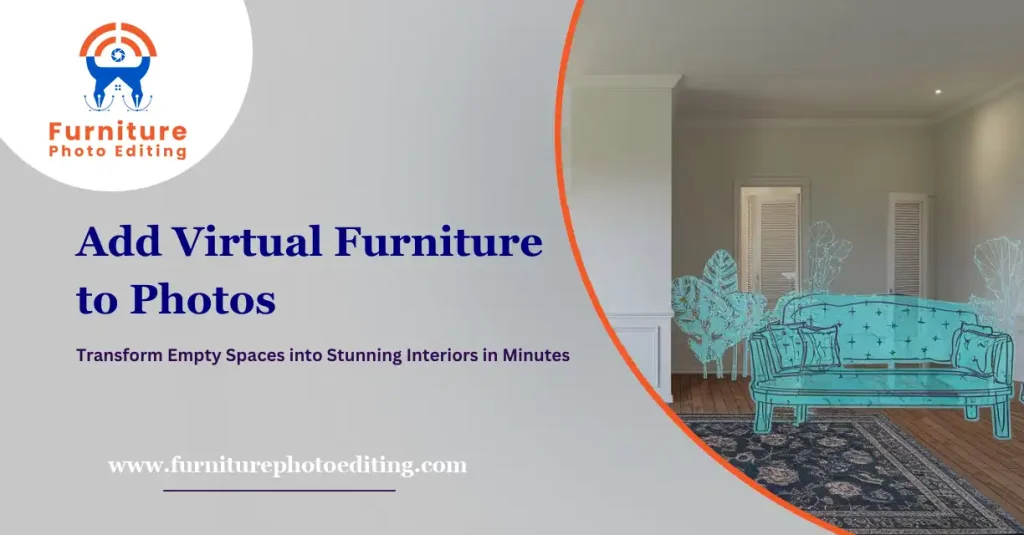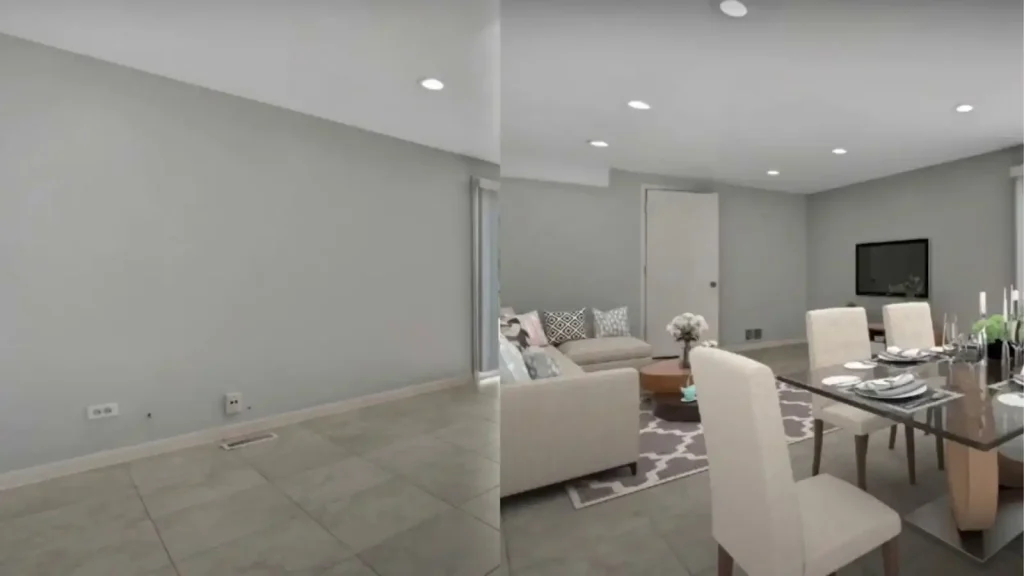How to Add Virtual Furniture to Your Photos?

Virtual furniture staging is a process that digitally adds furniture and decor to photos of empty spaces. By doing so, it transforms vacant rooms into inviting, well-decorated spaces, helping buyers visualize the property’s potential.
This guide explores the ins and outs of adding virtual furniture to your photos, blending traditional methods and AI-driven virtual staging. Whether you’re a realtor, photographer, or homeowner looking to enhance your property listings, this article will provide actionable insights, useful tools, and best practices.
What is Virtual Furniture Staging?
Virtual furniture staging involves using software to digitally add furniture, artwork, and decor to photos of empty rooms. Unlike physical staging—which requires renting and arranging real furniture—this technique is done entirely on a computer. The result is a visually stunning transformation without the hassle and cost of manual staging.

An empty room can seem uninviting, with buyers struggling to imagine how their belongings would fit. Virtual staging bridges this gap, enabling a buyer to connect emotionally with the property. When enhanced by AI, this process becomes faster, more customizable, and incredibly realistic.
Bring your interior designs to life with expert virtual furniture editing. Whether for staging, marketing, or conceptual visuals, we help you add realistic, stylish furniture to your photos seamlessly. Let our experts create stunning, lifelike spaces that captivate buyers and clients alike. Get a Free Furniture Photo Edit today and see for yourself how we can help you elevate your antique furniture business.
What Are the Benefits of Virtual Staging
The advantages of virtual staging, especially when integrated with AI tools, are significant for both sellers and buyers.
1. Cost-Effectiveness
Traditional staging involves renting furniture and hiring a professional stager, which can cost between $2,000 and $3,000 for a single home. Virtual staging, on the other hand, costs anywhere from $15 to $150 per photo, depending on the tool or service provider. By using AI-based solutions, you can achieve professional-quality staging at a fraction of the cost.
2. Time Efficiency
Where physical staging can take several days, virtual staging powered by AI can produce results in a matter of hours or even minutes. This speed allows agents to list properties faster and react to market demands without delay. For example, some tools like Pincel Architect can stage an entire home in under 24 hours.
3. Customization and Flexibility
Virtual staging allows you to experiment with a wide range of styles, layouts, and themes to cater to specific buyers. Want a sleek modern design for young professionals? Or a cozy, rustic look for families? AI tools provide the flexibility to tailor your staging to appeal to different markets.
4. Improved Buyer Experience
Staged homes have been shown to sell faster and for higher prices. According to the National Association of Realtors (NAR), 83% of buyers find it easier to visualize a property as their future home when it’s staged. Virtual furniture enhances this effect by presenting spaces in their best possible light.
5. Enhanced Visual Appeal
The power of virtual staging lies in its ability to transform a bland, empty room into a beautifully decorated space. For example, a before-and-after comparison of a vacant living room versus one with virtual furniture can dramatically increase a listing’s attractiveness. These staged photos capture attention and make listings stand out.
Step-by-Step: How to Add Virtual Furniture to Your Photos
1. Choose the Right Virtual Staging Tool
The first step is selecting a tool or service that fits your needs. With a growing market of virtual staging platforms, it’s essential to evaluate options based on their ease of use, image quality, customization features, and cost.

Image: adding virtual furniture using VisualStager
Here are some standout tools:
- Pincel Architect: Known for its AI-powered design and creativity slider, allowing precise staging tailored to unique spaces.
- Visual Stager: Affordable with a simple token-based system, ideal for small projects.
- PhotoUp: Offers a large furniture library and professional quality, along with fast turnaround times.
- Fotober: Focuses on quality control with a team of skilled designers ensuring every detail is perfect.
2. Prepare High-Quality Photos
The success of virtual staging depends heavily on the quality of your base photos. Sharp, well-lit, and properly angled images create a canvas that AI or virtual staging tools can work with effectively.
Key Tips for Perfect Photos:
- Use a wide-angle lens to capture as much of the room as possible.
- Ensure proper lighting to eliminate shadows. Natural light works best, but you can use soft artificial light when needed.
- Maintain straight vertical lines for professional results. Crooked photos can distort the final staging.
- Document unique room features like fireplaces, windows, and door placements.
Hiring a professional photographer might cost $150–$300 per session but ensures your photos are staging-ready.
3. Uploading and Staging Your Photos
Once you’ve chosen your staging tool and prepared your photos, the next step is to upload and begin staging. Most tools provide an intuitive process:
- Upload your image to the platform. High-resolution images ensure better staging quality.
- Select a design style that complements the property and appeals to your target buyers. Popular styles include modern, Scandinavian, and farmhouse chic.
- Use customization features to experiment with layouts, furniture choices, and decor. Adjust the placement, size, and color of furniture for a balanced and cohesive look.
For example, if you’re working with a living room, start by adding essentials like a sofa, coffee table, and rug. Then, enhance with accent pieces like throw pillows, lamps, and artwork.
How to Fine-Tune Your Staged Images
Once the initial virtual staging is complete, it’s crucial to fine-tune the images for the best possible outcome. This step ensures the staged photos look natural, professional, and appealing to potential buyers.
1. Check for Realism
The key to effective virtual staging is making the additions look like they belong in the photo. Carefully review the following aspects:
- Lighting and Shadows: Ensure that the virtual furniture matches the room’s natural lighting. Misaligned shadows can make the staging look fake.
- Perspective and Scale: Furniture should be proportionate to the room’s dimensions. Oversized or undersized pieces can distort the space’s perception.
Many tools, like BoxBrownie, use AI to automatically adjust lighting and perspective, reducing the likelihood of errors. However, manual checks are always advisable.
2. Adjust Color Balance
The colors of virtual furniture and decor should harmonize with the room’s existing tones, such as wall paint, flooring, and natural light. For instance, a brightly lit room with neutral walls might benefit from furniture in cool or muted tones to enhance the space’s openness.
3. Highlight Key Features
Your staging should emphasize the room’s best attributes, such as large windows, hardwood floors, or built-in features like shelves. Avoid placing furniture that obstructs these elements.
4. Optimize for Different Platforms
Listings on Zillow, Realtor.com, or social media platforms like Instagram and Facebook often compress images, which can affect quality. Use high-resolution files (300 DPI) and ensure they meet the specific platform’s size requirements.
How to Overcome Common Virtual Furniture Staging Issues?
Virtual furniture staging, while highly effective, does come with its share of challenges. Understanding these pitfalls can help you avoid mistakes and maximize the impact of your efforts.
1. Unrealistic Expectations
Buyers may feel disappointed if the staged images look dramatically different from the actual property. To mitigate this, always provide a mix of staged and empty room photos in your listing. Transparency builds trust and ensures buyers are not misled.
2. Over-Staging
Adding too many elements can make a room feel cluttered and overwhelming. A simple, minimalistic approach often works best, focusing on functionality and aesthetics. For instance, a bedroom only needs essentials like a bed, nightstands, and a lamp to convey its purpose.
3. Technical Limitations
Not all tools produce professional-grade results, especially free or low-cost options. Investing in reputable services or professional designers ensures a polished outcome.
Best Practices for Virtual Furniture Staging
1. Use Staging Strategically
Not every room in a property needs staging. Focus on key areas that buyers find most important:
- Living Rooms: Highlight communal and entertaining spaces.
- Master Bedrooms: Showcase comfort and luxury.
- Kitchens and Dining Areas: Emphasize functionality and warmth.
2. Align with Your Target Audience
Tailor the style of staging to your buyer demographic. For urban condos, sleek and modern designs work well. For suburban family homes, opt for cozy and functional setups.
3. Leverage Before-and-After Comparisons
Displaying side-by-side comparisons of vacant and staged rooms helps buyers understand the transformation. These visuals are powerful tools to drive interest and engagement.
Key Takeaways
Adding virtual furniture to your photos is a game-changing strategy for creating visually appealing property listings. It is cost-effective, time-saving, and incredibly versatile, allowing real estate professionals to tailor designs to their audience and market. By following best practices, leveraging cutting-edge tools, and focusing on authenticity, you can maximize the impact of virtual staging.
FAQs
Is virtual furniture staging legal?
Yes, virtual staging is completely legal as long as you disclose it in the property listing. Transparency ensures buyers are not misled.
Can I use virtual staging for commercial properties?
Absolutely! Virtual staging works for both residential and commercial spaces, helping potential tenants or buyers visualize the possibilities.
How long does virtual staging take?
With modern AI tools, virtual staging can take as little as 1–2 hours per photo. For custom designs, professional services may take 24–48 hours.
Does virtual furniture staging increase property value?
While it doesn’t directly increase property value, staged homes often sell faster and for higher prices because they leave a stronger impression on buyers.